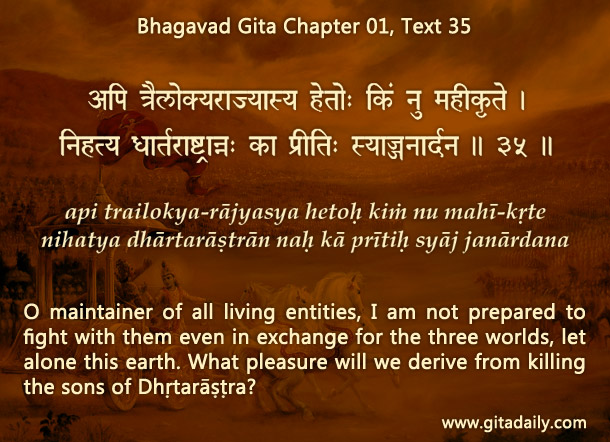At the start of the Bhagavad-gita, Arjuna is agonized at the thought of fighting in a fratricidal war that will kill most of his loved ones and indeed most of society’s martial guardians. While giving arguments against fighting, Arjuna refers to Krishna by the name Janaradana (01.35), one who is the maintainer of the worlds. The implication is: Why does the world’s maintainer want Arjuna to act in a way that would disrupt the world’s order?
Krishna responds to Arjuna by delineating the majestic worldview of the Gita. That worldview explains how Arjuna’s worst fears will materialize not if he adheres to Krishna’s instruction, but if he neglects that instruction. In the third chapter, the Gita outlines how if the dharmic heads of state didn’t do their duty of protecting dharma by fighting when necessary, then that bad precedent would make others similarly apathetic and irresponsible, thereby leaving dharma with no protectors. This would make the adharmic miscreants even more brazen and brutal, thereby plunging all of society into chaos.
At the time of the war, the adharmic Kauravas had unscrupulously grabbed power by cheating and exiling the dharmic Pandavas. If such miscreants were allowed to continue unchallenged and unchecked in power, they would mislead all of society into vice, thus disrupting all social order. In contrast, if Arjuna fought and re-established the rule of dharma, as Krishna desired, then social and spiritual order would be restored.
Similarly, in our lives too, following Krishna’s instruction may initially seem disruptive. But if we persevere, practicing dharma determinedly and sensitively, we will discover that it is actually restorative – it will bring lasting peace and happiness in our lives. And it will enable us to become channels of the divine for bringing a similar restoration of peace and happiness in others’ lives.
Explanation of article:
Gita-daily Podcast:




Hare Krishna Prabhuji
PAMHO
Thank you very much for such a wonderful article. Your last paragraph clearly points out how we can harmonize our material and spiritual lives in this human form.
Hari Bol
Narottama das
Nice explanation Maharaj !!!